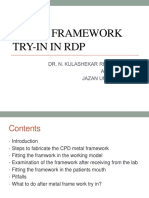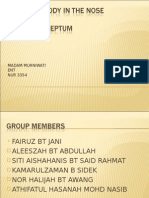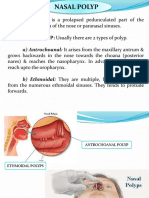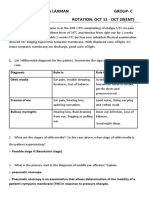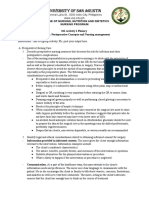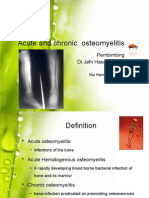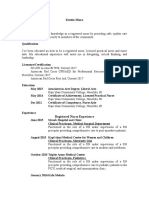0 ratings0% found this document useful (0 votes)
147 viewsForeign Body in Pharynx, Larynx, Trachea & Tracheobronchial Tree
This document discusses foreign bodies that become lodged in the pharynx, larynx, trachea, and tracheobronchial tree. It covers common sites of lodgement, causes, signs and symptoms, methods of diagnosis using imaging and investigation, and approaches to management including endoscopic removal or surgical procedures. Complications are also outlined such as respiratory obstruction, infection, perforation, and stricture formation. Diagnosis involves a thorough history and physical exam, with imaging like chest x-rays used to identify radiopaque objects. Management depends on the specific location, with options including rigid or flexible bronchoscopy, tracheostomy, or thoracotomy.
Uploaded by
hashyCopyright
© © All Rights Reserved
We take content rights seriously. If you suspect this is your content, claim it here.
0 ratings0% found this document useful (0 votes)
147 viewsForeign Body in Pharynx, Larynx, Trachea & Tracheobronchial Tree
This document discusses foreign bodies that become lodged in the pharynx, larynx, trachea, and tracheobronchial tree. It covers common sites of lodgement, causes, signs and symptoms, methods of diagnosis using imaging and investigation, and approaches to management including endoscopic removal or surgical procedures. Complications are also outlined such as respiratory obstruction, infection, perforation, and stricture formation. Diagnosis involves a thorough history and physical exam, with imaging like chest x-rays used to identify radiopaque objects. Management depends on the specific location, with options including rigid or flexible bronchoscopy, tracheostomy, or thoracotomy.
Uploaded by
hashyCopyright
© © All Rights Reserved
We take content rights seriously. If you suspect this is your content, claim it here.
You are on page 1/ 26
FOREIGN BODY IN
PHARYNX,LARYNX, TRACHEA &
TRACHEOBRONCHIAL TREE
Foreign Bodies of Food Passage
• Site of lodgement
• Aetiology
• Signs & symptoms
• Investigation
• Management
• Complication
Foreign Bodies of Food Passage
• An ingested foreign body (FB) may lodge in:
1. The tonsil
2. The base of tongue/vallecula
3. Posterior pharyngeal wall
4. The pyriform fossa
5. The oesophagus
SITE OF LODGEMENT OF FOREIGN BODY
• The commonest site is at or just below the cricopharyngeal sphincter.
• Flat objects like coins are held up at the sphincter while others are held in
the upper oesophagus just below the sphincter due to poor peristalsis.
• Foreign bodies which pass the sphincter can be held up at the next
narrowing at bronchoaortic constriction or at the cardiac end.
• Sharp or pointed objects lodge anywhere in the oesophagus.
• Once object passes the oesophagus it is likely to pass per rectum but
sometimes it gets obstructed at pylorus, duodenum, terminal ileum,
ileocaecal junction, caecum, sigmoid colon or even at the rectum.
• Size and shape of the object and its nature, sharp or pointed plays an
important part in its lodgement in oesophagus or lower down.
AETIOLOGY
1. Age.
o Children below 5 years old
o Put anything in the mouth
o Educate parents to avoid such accidents .
2. Loss of protective mechanism
o Swallowed of foreign body undetected
o loss of consciousness, epileptic seizures & deep sleep.
3. Carelessness
o Poorly prepared food
o improper mastication
o Hasty eating and drinking.
4. Narrowed oesophageal lumen
o Oesophageal stricture or carcinoma.
5. Psychotics
o Attempt to commit suicide.
CLINICAL FEATURES
SYMPTOMS
1) History of initial choking or gagging
2) Discomfort or pain located just above the clavicle on the right or left of trachea.
Discomfort increases on attempts to swallow.
3) Dysphagia.
4) Drooling of saliva.
5) Respiratory distress.
6) Substernal or epigastric pain.
7) In partial obstruction, patient may still be taking normal food with little or no
discomfort for a few days. Even X-rays may be normal. No complacency should
be observed and an endoscopic examination performed when history and
physical examination strongly suggest a foreign body
CLINICAL FEATURES
SIGNS
1) Tenderness in the lower part of neck on the right or left of trachea
2) Pooling of secretions in the pyriform fossa on indirect laryngoscopy.
They do not disappear on swallowing
3) Sometimes a foreign body may be seen protruding from the
oesophageal opening in the postcricoid region.
INVESTIGATIONS
• Posteroanterior & lateral view of chest X-Ray.
• Radio-opaque foreign body & location detected.
• Failure to see FB doesn’t rule out FB (small, plastic or radiolucent).
• Barium swallowing avoided as delays other procedures.
MANAGEMENT
1. Endoscopic removal.
2. Cervical oesophagotomy.
3. Transthoracic oesophagotomy.
COMPLICATIONS OF OESOPHAGEAL FOREIGN
BODY
1) Respiratory obstruction. This is due to tracheal compression by the
FB in the oesophagus, or laryngeal oedema especially in infants and
children.
2) Perioesophageal cellulitis and abscess. It occurs in the neck.
3) Perforation. Sharp objects may perforate the oesopha- geal wall,
setting up mediastinitis, pericarditis or empy- ema. They may
perforate the aorta and prove fatal.
4) Tracheo-oesophageal fistula. Rare
5) Ulceration and stricture. Overlooked foreign bodies maycause slow
ulceration and stricture formation.
FOREIGN BODIES OF AIR PASSAGE
• Site of lodgement
• Aetiology
• Signs & symptoms
• Diagnosis
• Investigation
• Management
FOREIGN BODIES OF AIR PASSAGE
• A foreign body aspirated into air passage can lodge in the larynx,
trachea or bronchi.
• Site of lodgement would depend on the size, shape and nature of the
foreign body.
• A large foreign body, unable to pass through the glottis, will lodge in the
supraglottic area while the smaller one will pass down through the
larynx into the trachea or bronchi.
• Foreign bodies with sharp points, e.g. pins, needles, fish bones, etc. can
stick anywhere in the larynx or tracheobronchial tree.
AETIOLOGY
• Children below 4 years old are often affected.
• Accidents occur when they suddenly inspire during play or fight while
having something in the mouth.
• In adults, foreign bodies are aspirated during coma, deep sleep or
alcoholic intoxication. Loose teeth or denture may be aspirated during
anaesthesia
• Common in children:
vegetable foreign body Non vegetable body
Peanut plastic whistle
almond seed plastic toys
peas, beans safety pins
gram or wheat seed Nails
watermelon seed all-pin
pieces of carrot or apple twisted wires
ball bearings
CLINICAL FEATURES
• Initial period of choking, gagging and wheezing
• Symptomless interval
• Later symptoms – due to airway obstruction, inflammation or trauma
Laryngeal foreign body
Large FB can totally obstruct the airways causing sudden death unless urgent resuscitation.
Partial obstruction cause discomfort or pain in throat, hoarseness of voice, croupy cough,
aphonia, dyspnoea, wheezing and haemoptysis.
Tracheal foreign body
Sharpe FB produce cough & haemoptysis.
Loose foreign body like seed may move up and down the trachea between the carina and the
undersurface of vocal cords causing “audible slap” and “palpatory thud.”
Asthmatoid wheeze may also be present. It is best heard at patient’s open mouth.
Bronchial foreign body
Most foreign bodies enter the right bronchus because it is wider and more in line with the
tracheal lumen.
A FB may totally obstruct a lobar or segmental bronchus causing atelectasis or it may produce
a check valve obstruction, allowing only ingress of air but, not the egress, thus leading to
obstructive emphysema
DIAGNOSIS
• Detailed history of the foreign body “ingestion”.
A history of sudden onset of coughing
Wheezing
Diminished entry of air into the lungs on auscultation
High index of suspicion in children with wheezing, stridor, cough or asthma
Those with recurrent chest infections being treated with steroids and
antibiotics
• Physical examination of the neck and chest.
INVESTIGATION
• Plain X-ray chest in posteroanterior and lateral views.
• X-ray chest at the end of inspiration and expiration.
• Fluoroscopy/videofluoroscopy.
• CT chest
MANAGEMENT OF LARYNGEAL FB
• Heimlich manoeuvre. Stand behind the person and place your arms
around his lower chest and give four abdominal thrusts. The residual
air in the lungs may dislodge the foreign body providing some
airway.DO NOT PERFORM THIS MEASURES IN PARTIALLY OBSTRUCTED
PATIENT.
• Cricothyrotomy or emergency tracheostomy should be done if
Heimlich manoeuvre fails.
• Once acute respiratory emergency is over, foreign body can be
removed by direct laryngoscopy or by laryngofissure, if impacted.
MANAGEMENT OF TRACHEOBRONCHIAL FB
• Methods to remove tracheobronchial foreign body:
1) Conventional rigid bronchoscopy
2) Rigid bronchoscopy with telescopic aid
3) Bronchoscopy with C-arm fluoroscopy
4) Use of Dormia basket or Fogarty’s balloon for rounded objects
5) Tracheostomy first and then bronchoscopy through the
tracheostomy
6) Thoracotomy and bronchotomy for peripheral foreignbodies
7) Flexible fibreoptic bronchoscopy in selected adult patients
MANAGEMENT OF TRACHEOBRONCHIAL FB
1) Bronchoscope, appropriate for the age of patient and a size smaller
and the other a size larger
2) Telescope or optical forceps
3) Two laryngoscopes
4) Foreign body forceps, Dormia basket, Fogarty’s catheterand a
syringe to inflate it.
THE END
You might also like
- Download Full Scott-Brown’s Otorhinolaryngology and Head and Neck Surgery: Volume 3: Head and Neck Surgery, Plastic Surgery John C Watkinson PDF All Chapters100% (2)Download Full Scott-Brown’s Otorhinolaryngology and Head and Neck Surgery: Volume 3: Head and Neck Surgery, Plastic Surgery John C Watkinson PDF All Chapters62 pages
- Pediatric Otolaryngology (American Academy of Pediatrics) ( Etc.)English (Z-Library)No ratings yetPediatric Otolaryngology (American Academy of Pediatrics) ( Etc.)English (Z-Library)511 pages
- List of Questions For Oral Part of Ent ExamNo ratings yetList of Questions For Oral Part of Ent Exam4 pages
- Deep Neck Space Infections: Best Viewed As A Powerpoint Slideshow To Insure That Overlays Are SeenNo ratings yetDeep Neck Space Infections: Best Viewed As A Powerpoint Slideshow To Insure That Overlays Are Seen43 pages
- Aero Digestive Tract Foreign Bodies: by Macktevin MalamshaNo ratings yetAero Digestive Tract Foreign Bodies: by Macktevin Malamsha53 pages
- Foreign Bodies of Air Passages and Food PassageNo ratings yetForeign Bodies of Air Passages and Food Passage20 pages
- Thyroglossal Duct Cysts, A Simple Guide To The Condition, Diagnosis, Treatment And Related ConditionsFrom EverandThyroglossal Duct Cysts, A Simple Guide To The Condition, Diagnosis, Treatment And Related ConditionsNo ratings yet
- Lecture Notes on Diseases of the Ear Nose and Throat 9th Edition P. D. Bull all chapter instant download100% (9)Lecture Notes on Diseases of the Ear Nose and Throat 9th Edition P. D. Bull all chapter instant download81 pages
- ENT Rajiv Dhawan Test FMGE July 2024 - Questions - Done-1No ratings yetENT Rajiv Dhawan Test FMGE July 2024 - Questions - Done-114 pages
- Dse Pathogenesis/ Causes Diagnosis Complications TX Prognosis NotesNo ratings yetDse Pathogenesis/ Causes Diagnosis Complications TX Prognosis Notes5 pages
- (Ent) 02 Endoscopy Applied Physiology EditedNo ratings yet(Ent) 02 Endoscopy Applied Physiology Edited5 pages
- E.N.T Guide For Medical Students: Neck Examination: Dr. Giovanni Henry ENT Resident 2016No ratings yetE.N.T Guide For Medical Students: Neck Examination: Dr. Giovanni Henry ENT Resident 201679 pages
- Mcqs in Ear Nose and Throat Dhingra 177 210No ratings yetMcqs in Ear Nose and Throat Dhingra 177 21034 pages
- A Case Report On - A Rare Case of Laryngocele in A Young Male MenNo ratings yetA Case Report On - A Rare Case of Laryngocele in A Young Male Men4 pages
- ENT - Diseases of The Nose and Paranasal SinusesNo ratings yetENT - Diseases of The Nose and Paranasal Sinuses8 pages
- Cholesteatoma: Clinical Features Diagnosis TreatmentNo ratings yetCholesteatoma: Clinical Features Diagnosis Treatment19 pages
- 22 - Toronto Notes 2011 - Otolaryngology - Head and Neck Surgery100% (1)22 - Toronto Notes 2011 - Otolaryngology - Head and Neck Surgery48 pages
- Cholesteatoma Investigations & ManagementNo ratings yetCholesteatoma Investigations & Management28 pages
- Diseases of External Nose and VestibuleNo ratings yetDiseases of External Nose and Vestibule45 pages
- Work Book ENT by DR Rajiv Dhawan AMA (1) - 241005 - 151301No ratings yetWork Book ENT by DR Rajiv Dhawan AMA (1) - 241005 - 151301149 pages
- Thyroid Surgery: Preventing and Managing ComplicationsFrom EverandThyroid Surgery: Preventing and Managing ComplicationsPaolo Miccoli4/5 (844)
- Paroxysmal Nocturnal Hemoglobinuria, A Simple Guide To The Condition, Diagnosis, Treatment And Related ConditionsFrom EverandParoxysmal Nocturnal Hemoglobinuria, A Simple Guide To The Condition, Diagnosis, Treatment And Related ConditionsNo ratings yet
- Ludwig’s Angina, A Simple Guide To The Condition, Diagnosis, Treatment And Related ConditionsFrom EverandLudwig’s Angina, A Simple Guide To The Condition, Diagnosis, Treatment And Related ConditionsNo ratings yet
- jama_carlo_2025_oi_250027_1745441661.69297No ratings yetjama_carlo_2025_oi_250027_1745441661.6929710 pages
- I Kaposi’ S Sarcoma I A Presenting Sign of HIVNo ratings yetI Kaposi’ S Sarcoma I A Presenting Sign of HIV4 pages
- Clinical and Basic Immunodermatology 1st Edition Complete Chapter Download100% (3)Clinical and Basic Immunodermatology 1st Edition Complete Chapter Download16 pages
- COVID-19 Compared To Other Pandemic DiseasesNo ratings yetCOVID-19 Compared To Other Pandemic Diseases17 pages
- A. Pathway: (Lutfi, 2007 Smeltzer, 2000: 360)No ratings yetA. Pathway: (Lutfi, 2007 Smeltzer, 2000: 360)1 page
- Instant Access to (Ebook) Beischer & MacKay’s Obstetrics, Gynaecology and the Newborn by Michael Permezel, Susan Walker, Kypros Kyprianou ISBN 9780729583817, 9780729583824, 9780729584050, 0729583813, 0729583821, 0729584054 ebook Full Chapters100% (1)Instant Access to (Ebook) Beischer & MacKay’s Obstetrics, Gynaecology and the Newborn by Michael Permezel, Susan Walker, Kypros Kyprianou ISBN 9780729583817, 9780729583824, 9780729584050, 0729583813, 0729583821, 0729584054 ebook Full Chapters67 pages
- (Ebook) Controversies In Diabetic Neuropathy by Nigel A. Calcutt and Paul Fernyhough (Eds.) ISBN 9780128039151, 9780128039403, 0128039159, 012803940Xpdf download100% (5)(Ebook) Controversies In Diabetic Neuropathy by Nigel A. Calcutt and Paul Fernyhough (Eds.) ISBN 9780128039151, 9780128039403, 0128039159, 012803940Xpdf download47 pages
- Managing Complications of Submental Artery Involvement After Hyaluronic Acid Filler Injection in Chin RegionNo ratings yetManaging Complications of Submental Artery Involvement After Hyaluronic Acid Filler Injection in Chin Region4 pages
- Buy ebook (Ebook) Ward Rounds in Obstetrics and Gynecology by Sunanda R. Kulkarni; K. Srinivas ISBN 9789390020195, 9390020190 cheap price100% (6)Buy ebook (Ebook) Ward Rounds in Obstetrics and Gynecology by Sunanda R. Kulkarni; K. Srinivas ISBN 9789390020195, 9390020190 cheap price81 pages
- List of Dental Provider Network 2023-0801 (3)No ratings yetList of Dental Provider Network 2023-0801 (3)226 pages
- Chronic Suppurative Otitis Media - Background, Anatomy, PathophysiologyNo ratings yetChronic Suppurative Otitis Media - Background, Anatomy, Pathophysiology4 pages






